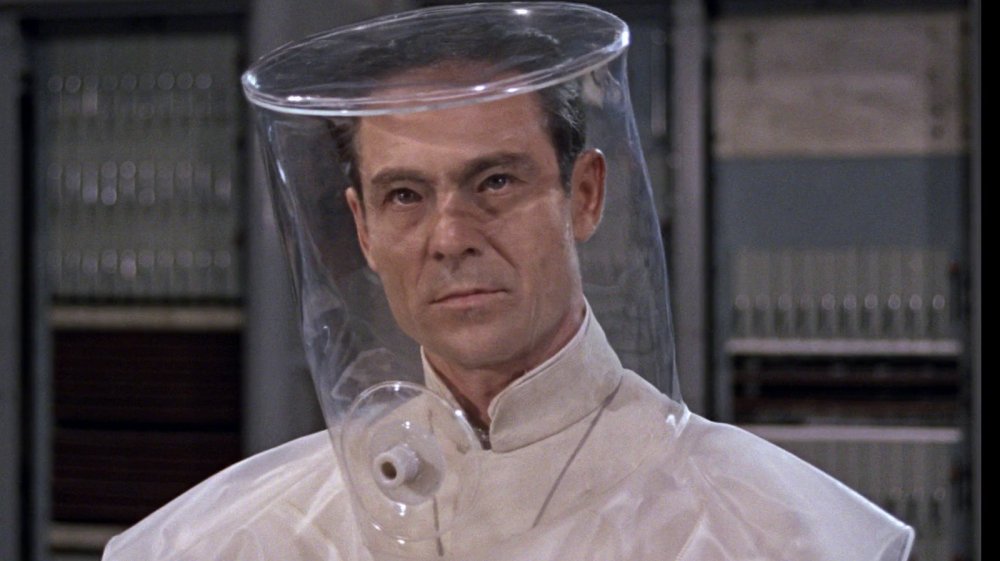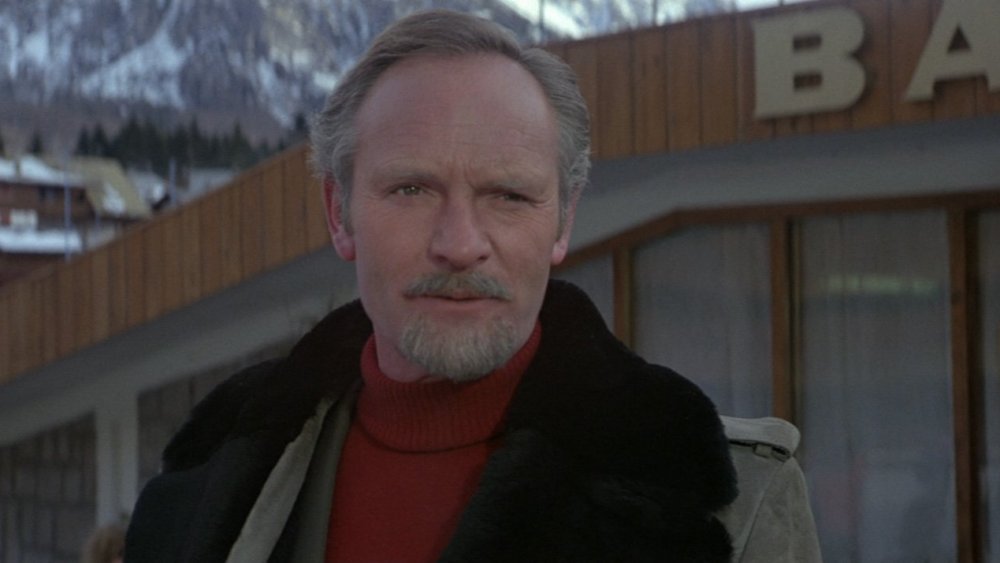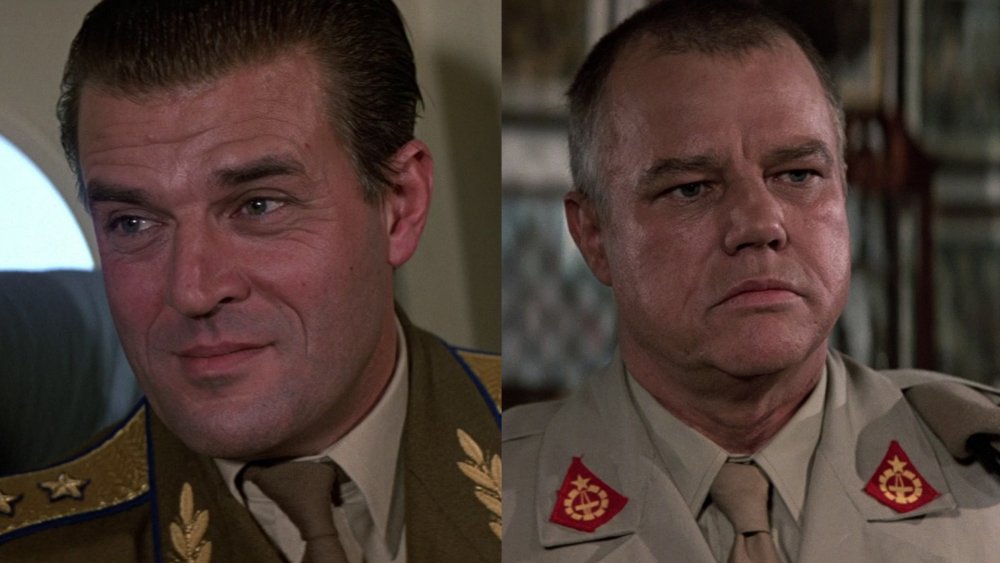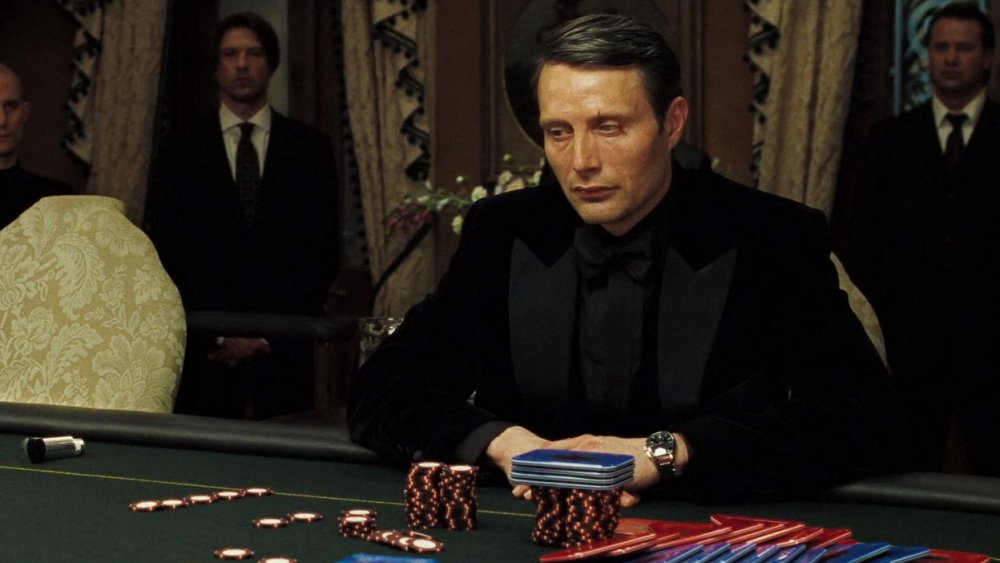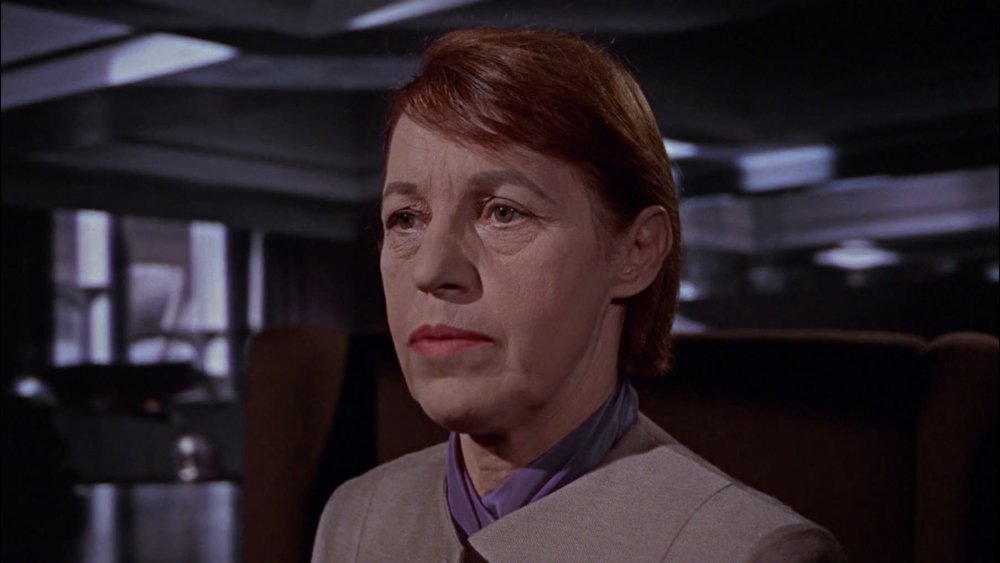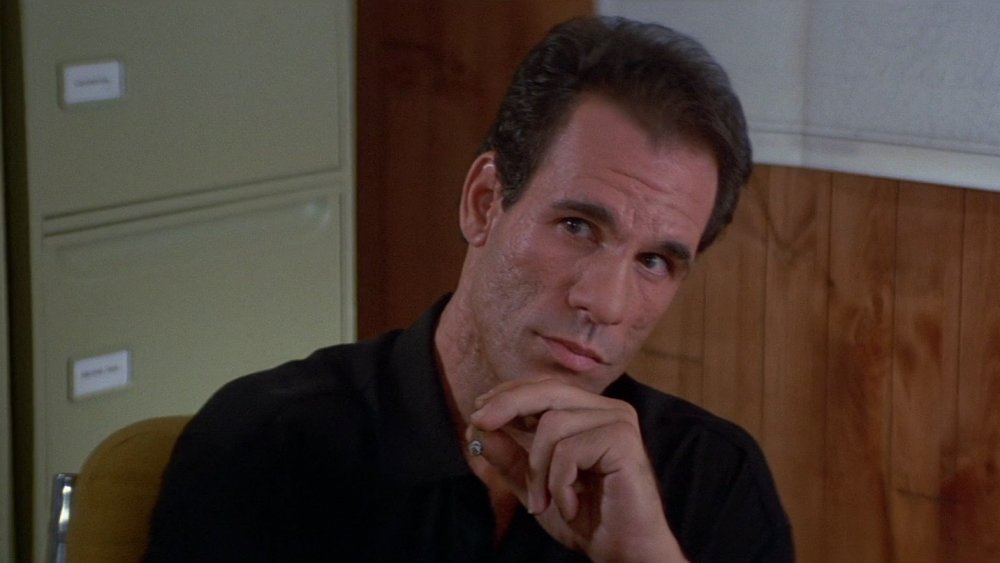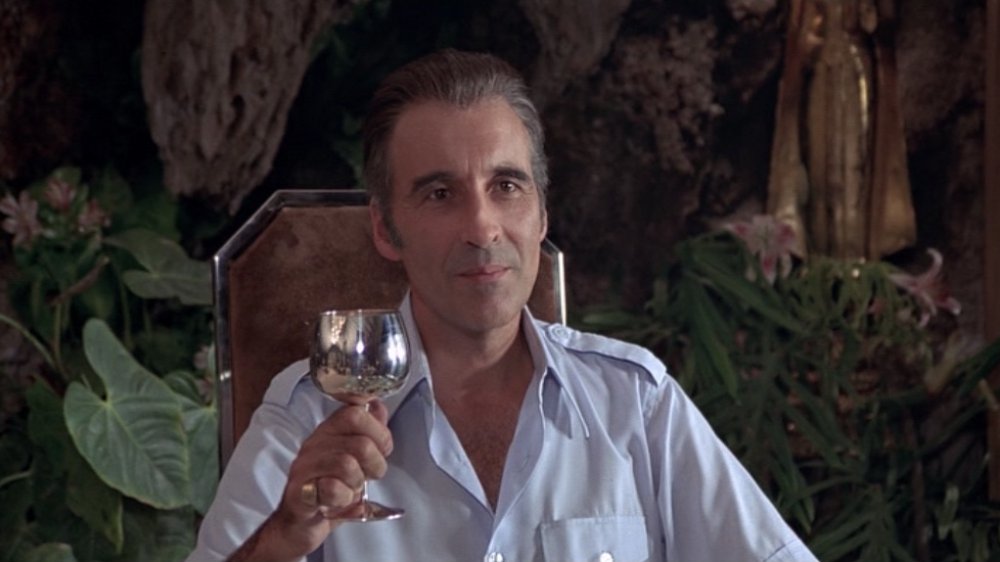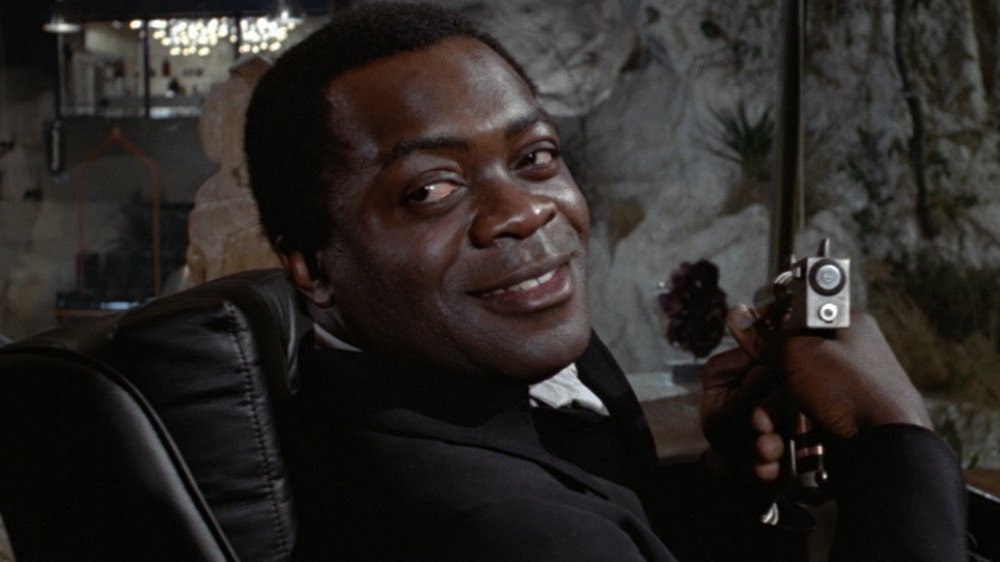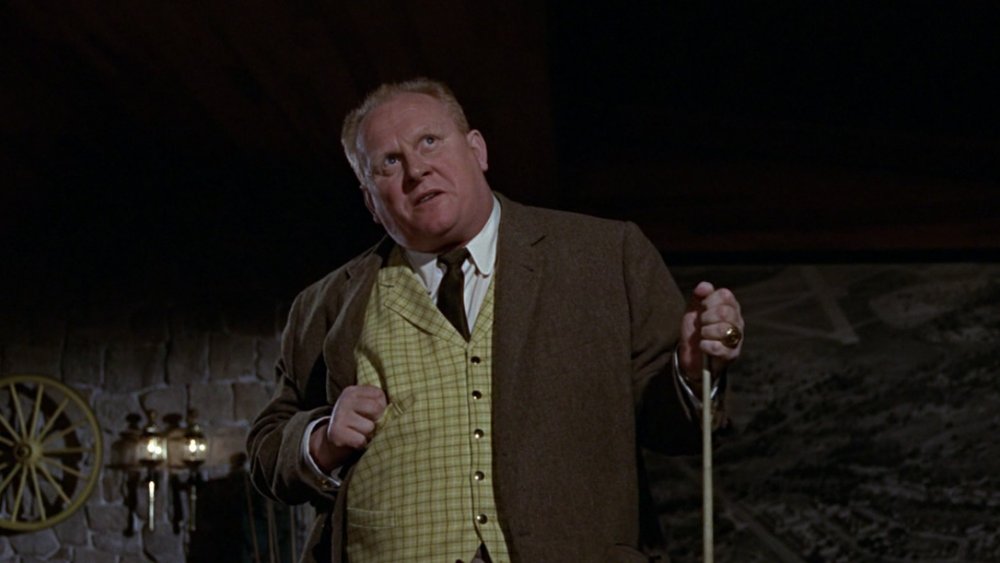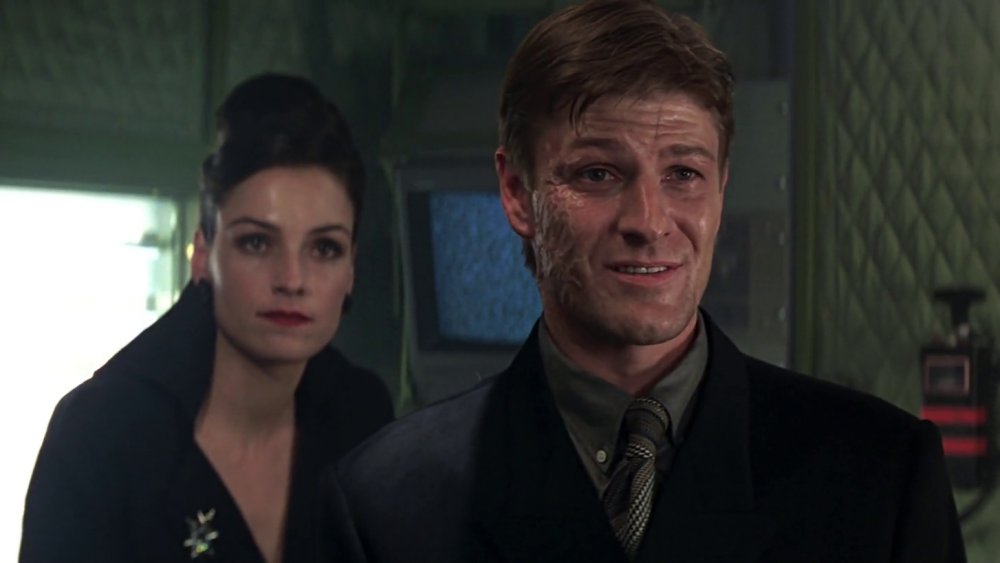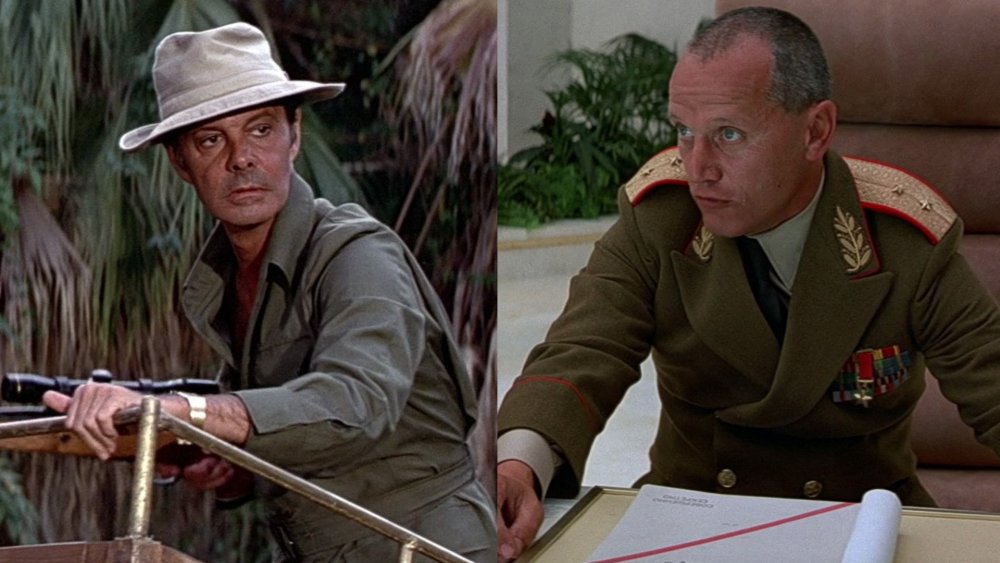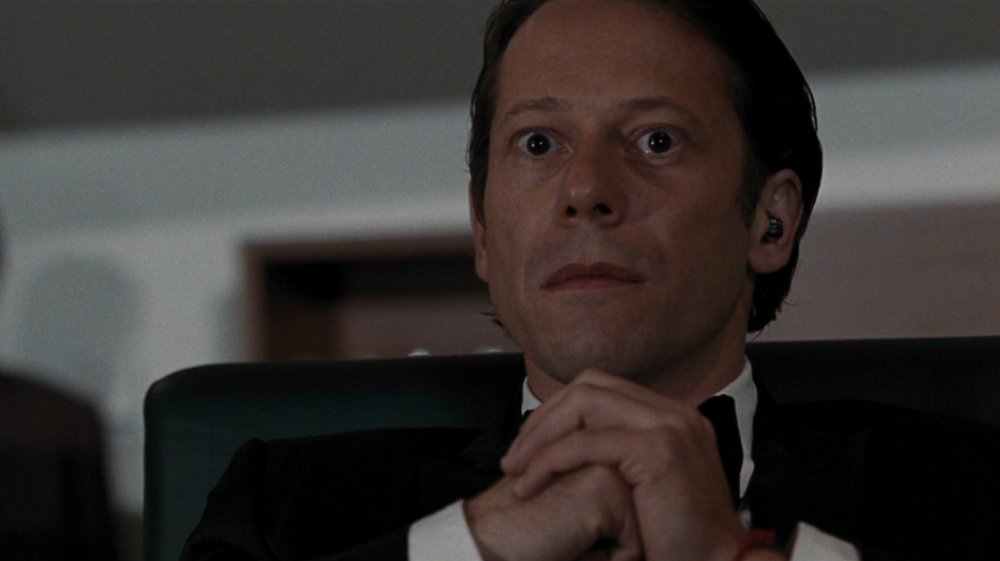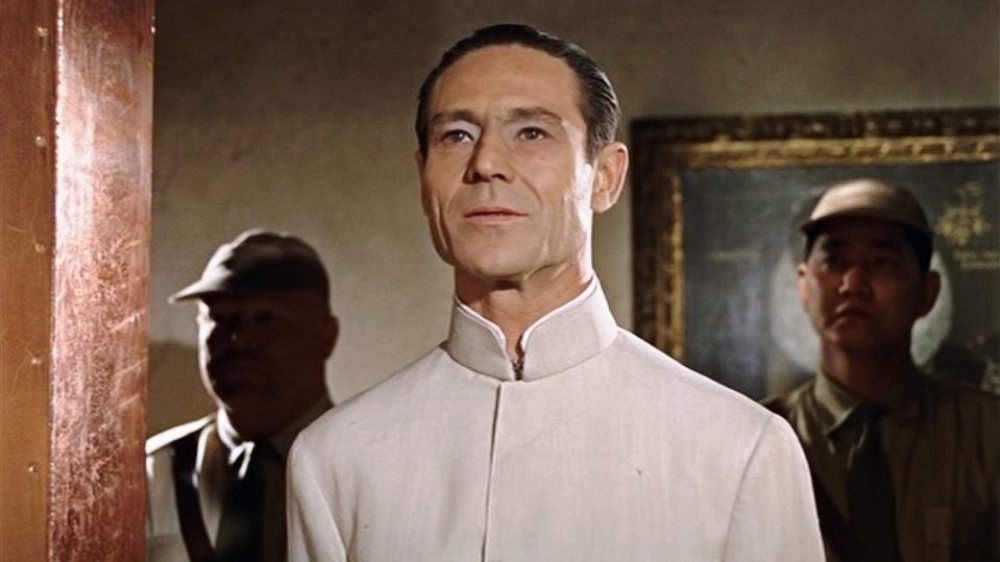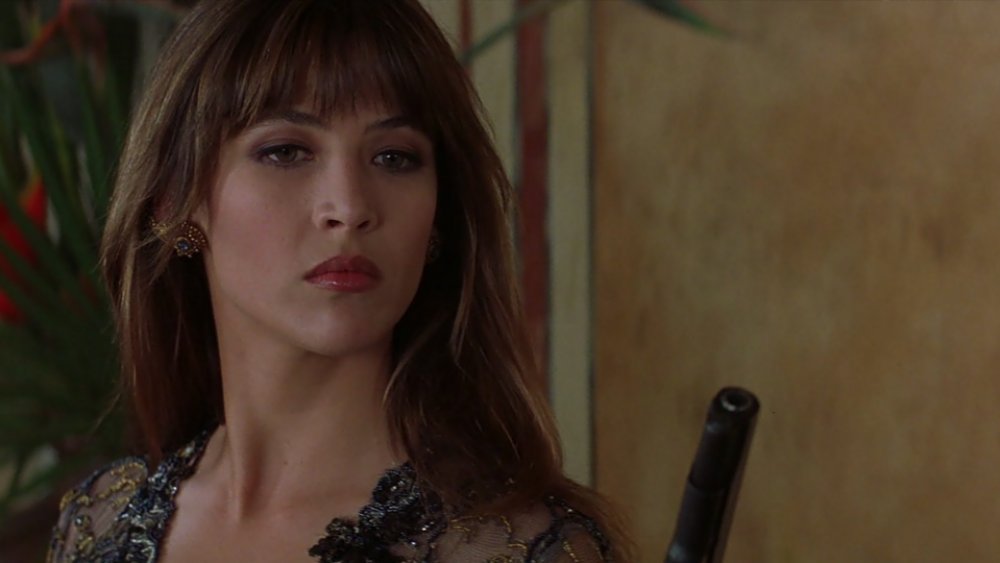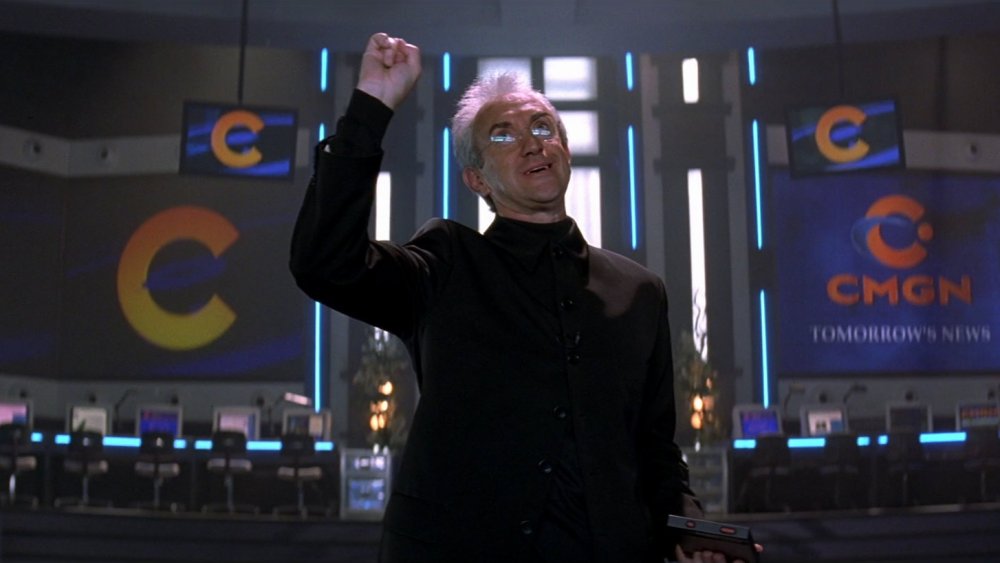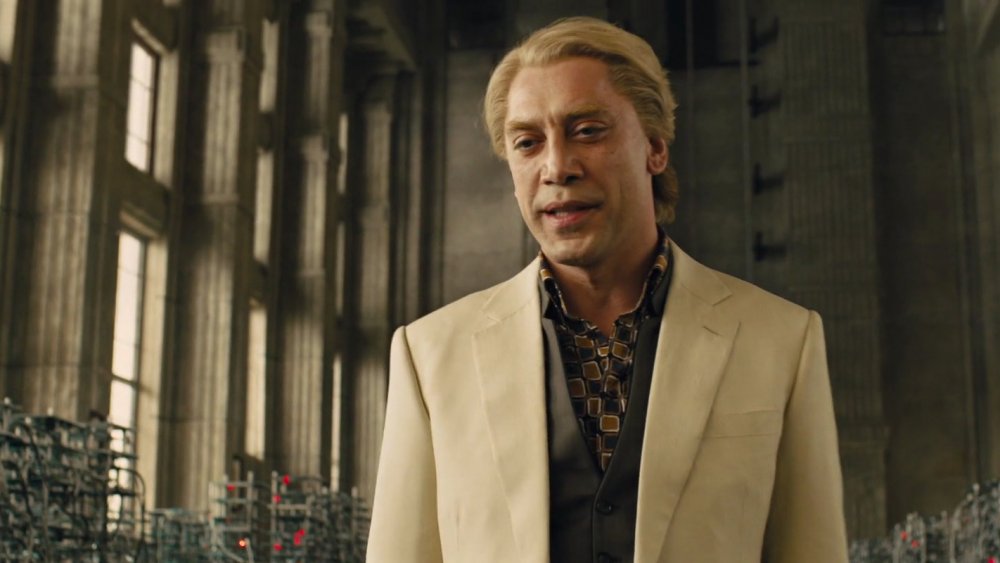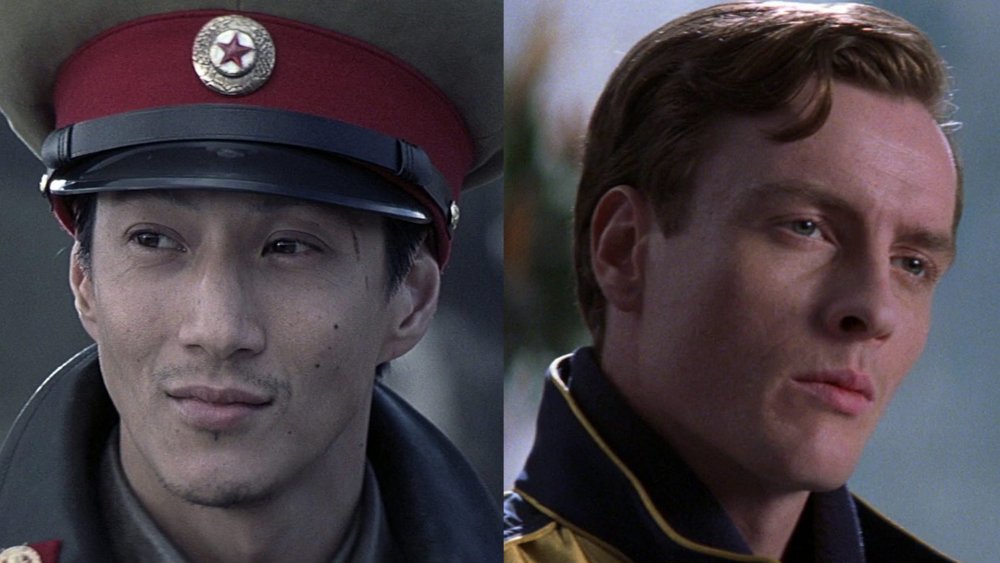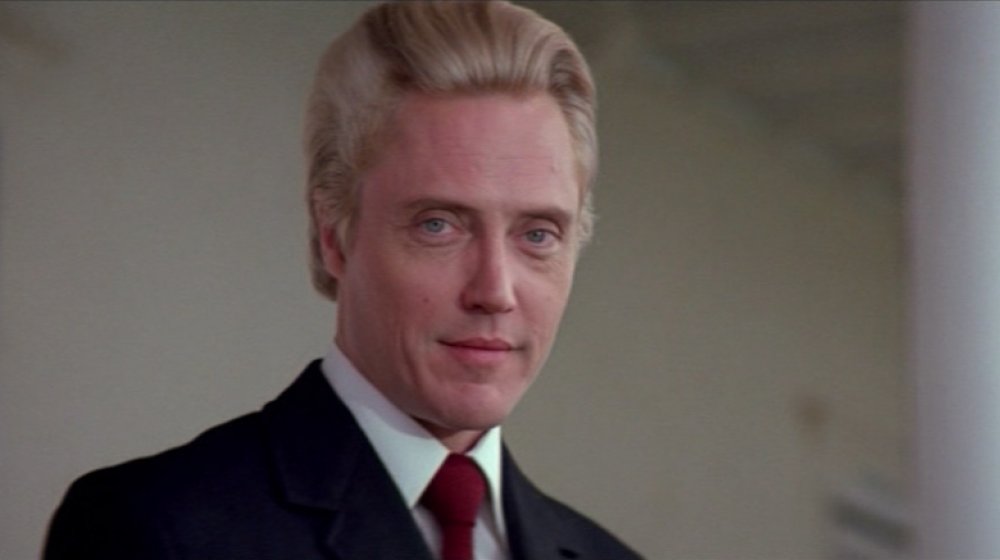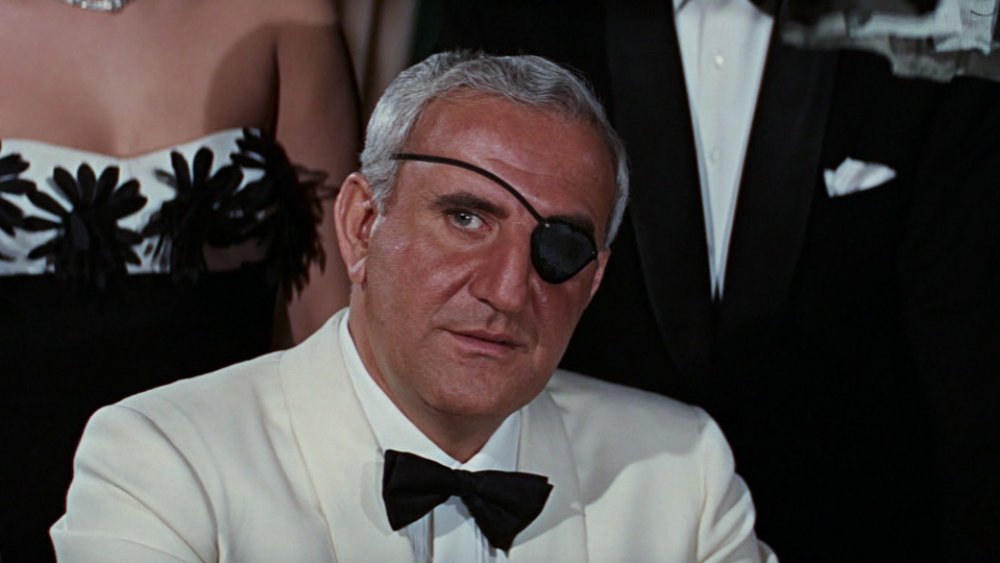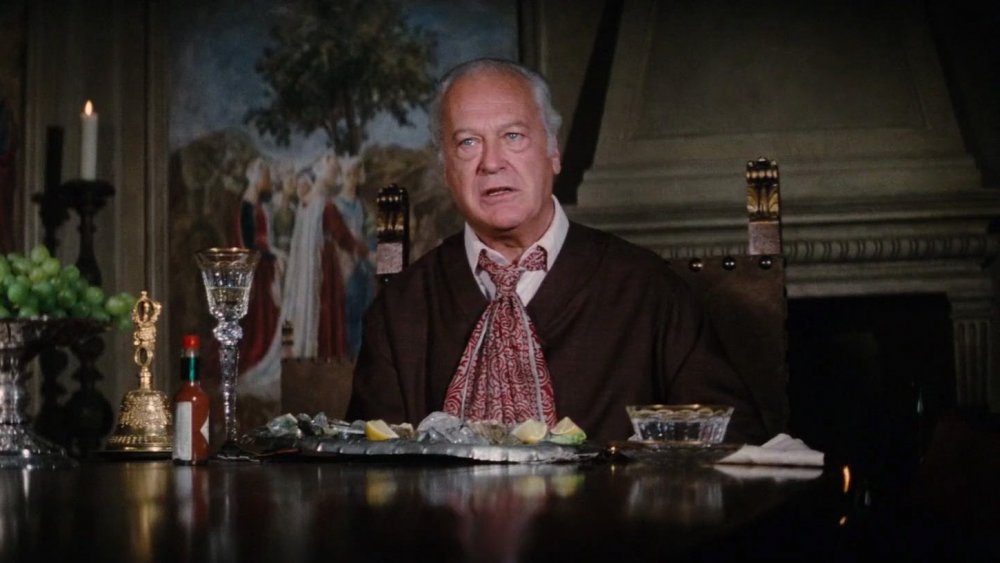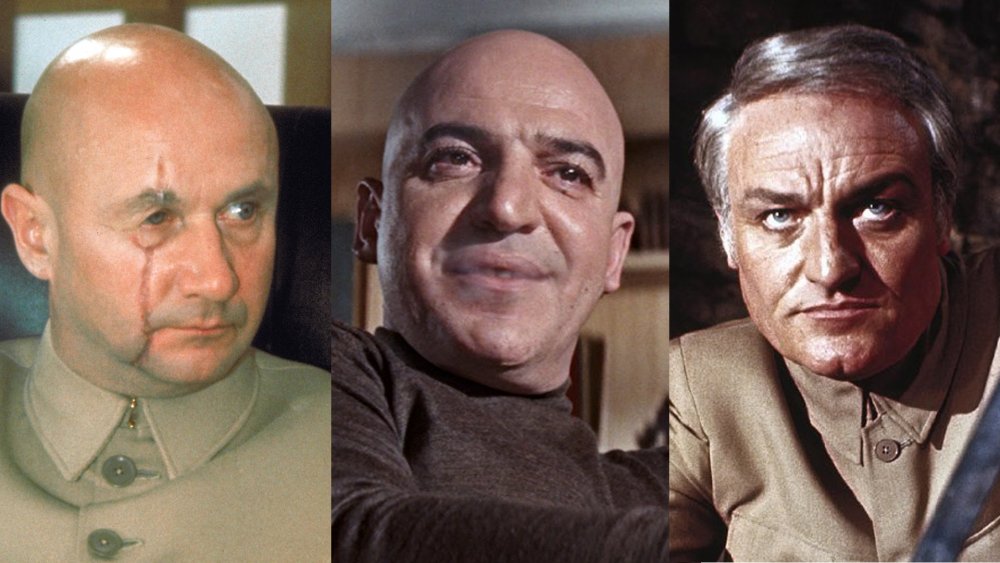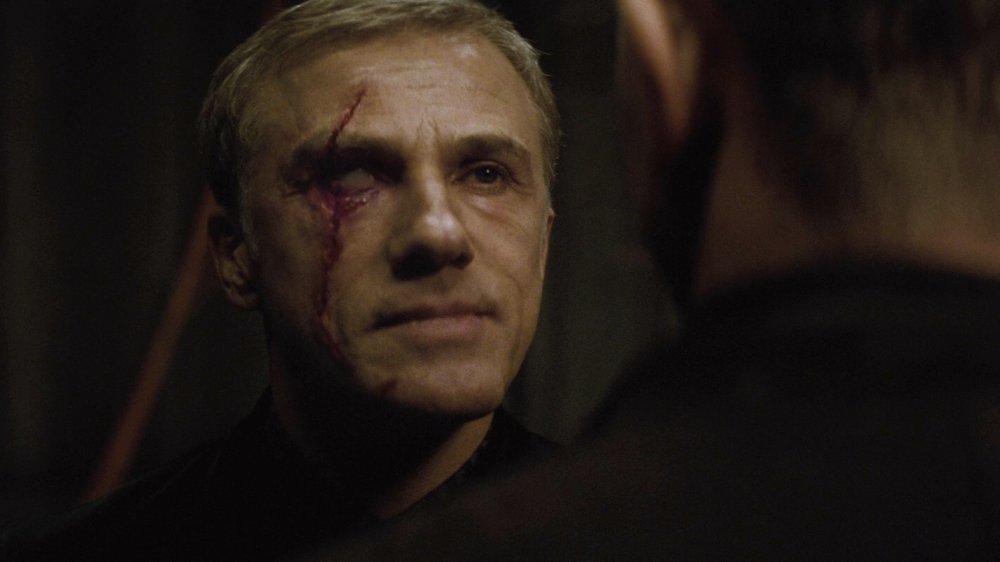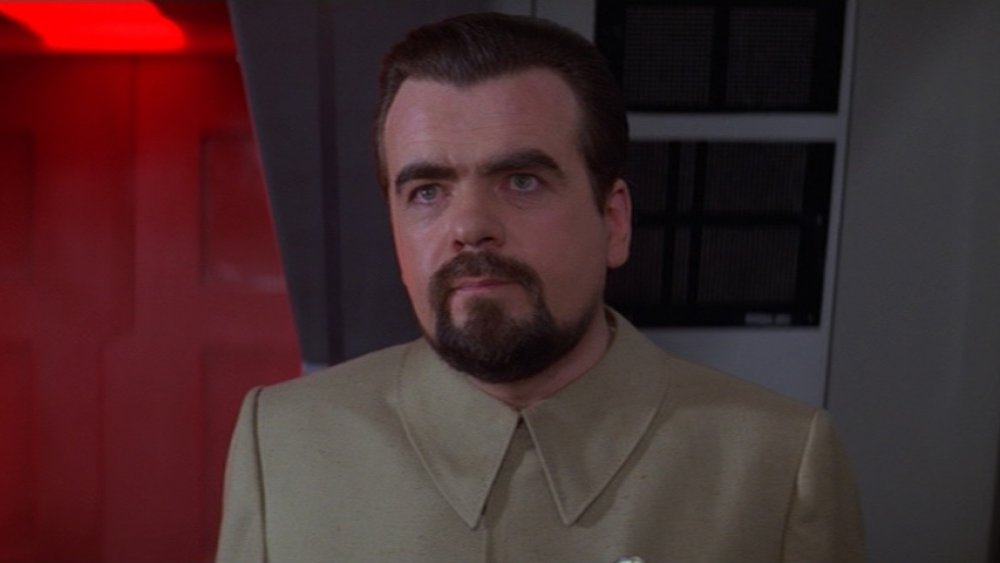Ranking The Most Powerful Villains In James Bond Films
Ever since making the leap from page to screen in 1962, British spy and assassin James Bond has been one of cinema's most famous and most prolific protagonists. Bond is the star of 25 films in the EON Productions series alone, as many as Batman, Iron Man, and Harry Potter combined. As genres and trends go in and out of fashion, the James Bond film franchise has remained as indestructible as the man himself.
But of course, no action hero could survive for over half a century without compelling and memorable villains with whom to do battle, and the James Bond series has contributed some of the most iconic bad guys ever to menace the silver screen. In the pantheon of film antagonists, Bond villains are in a league all their own, famous for distinct looks and gimmicks, beautifully designed hideouts, and plans for world domination. As the series has evolved, Bond films have oscillated between stylized spy thrillers and off-the-wall sci-fi adventures, and the scope of the villains' plans has fluctuated accordingly. Some of Bond's best films have had relatively low stakes, while in others, the fate of the entire human race is in jeopardy.
In ranking Bond's most powerful villains, we set aside the subjective quality of the films in which they star and decided on a single base criteria: If Bond isn't around to stop them, how much damage could they do? Our results may surprise you.
Aristotle Kristatos
The James Bond film franchise has developed a life cycle of sorts. At the start of each generation, the series aims to be a down-to-earth spy thriller with plausible plots, realistic action, and a vulnerable protagonist. Over the course of a few films, the threats get bigger, the gadgets and gimmicks get goofier, and Bond becomes less of a spy and more of a superhero. Once critics and audiences decide the series has gotten too broad, the producers pull back and bring it "back to basics" and the whole thing starts over again, usually with a new leading man.
Roger Moore portrayed James Bond for so long that he actually went through the cycle twice. After the outlandish Moonraker, EON Productions sought to return the series to its roots with the relatively restrained For Your Eyes Only, released in 1981. That film's central villain is Aristotle Kristatos (Julian Glover), a Greek businessman introduced as Bond's ally in his pursuit of a missing British ATAC missile targeting computer. Kristatos is actually trying to get his hands on the ATAC so he can sell it to the KGB.
Kristatos has no plans for world domination and no terrifying superweapon, just a couple of hired guns and a strongman on loan from the KGB. Kristatos doesn't even win the honor of being killed by Bond himself, and is instead dispatched by the man he tried to frame for his plot.
General Georgi Koskov & Brad Whitaker
The lifecycle started over once again with 1987's The Living Daylights, starring Timothy Dalton as a more sinister, brooding Bond. Soviet General Georgi Koskov (Jeroen Krabbé) tries to trick MI6 into assassinating his rival, General Pushkin, so he can take his place as the head of the KGB. Koskov's scheme drives much of the plot of The Living Daylights, but he shares the billing of Bond Villain for this feature with American arms dealer Brad Whitaker (Joe Don Baker), a West Point washout who wears a bootleg military uniform and fancies himself a spiritual descendent of Napoleon.
These two men, together, make up a single Bond villain. Koskov has the plan, and the loyalty of clinical assassin and infiltrator Necros. Whitaker has the secret lair and the army of minions at his disposal. Their aims are pretty small-ball for a Bond film — Koskov is angling for a big promotion and Whitaker wants to keep his best customer — but they represent a threat to détente between the Soviet Union and NATO, and an end to the Cold War. Since their plot to remove Pushkin fails, Koskov and Whitaker never achieve the level of power they'd need to be a major threat to peace. Whitaker loses a gunfight with Bond, and Koskov is sent home to the USSR in "a diplomatic bag."
Le Chiffre
After the James Bond franchise arguably hit rock bottom with Die Another Day, it was time to give the series not only a new Bond (Daniel Craig) but a hard reboot, casting aside the loose continuity of the previous 20 films. This meant finally giving Casino Royale, the original James Bond novel, a proper film adaptation in 2005, and introducing the original Bond villain — Le Chiffre (Mads Mikkelsen) — to the screen.
Le Chiffre is investor and financier to some of the world's most dangerous terrorists, using foreknowledge of their plots to reap massive windfalls. Before the events of Casino Royale, Le Chiffre is implied to have been privy to the 9/11 attacks, making a fortune from short-selling airline stocks. In the film, Le Chiffre seeks to reproduce this grisly windfall by sabotaging the debut of a new jet liner, but this plot fails due to the intervention of a fresh 00 agent named James Bond, which causes Le Chiffre to lose millions of dollars and puts him deeply in debt to some very dangerous people.
Needing to get rich quick, Le Chiffre does what any mathematical genius in his position would do — he hits the poker table. This, too, backfires when Bond wins the tournament. Le Chiffre makes one last play for the money, kidnapping and torturing Bond. Bond won't break, but he would likely have been killed if not for one of Le Chiffre's own clients breaking up the party and executing Le Chiffre for his carelessness.
Rosa Klebb
One of the earliest and most memorable Bond villains, Rosa Klebb (Lotte Lenya) is the mysterious assassin and spymaster assigned to destroy Sean Connery's James Bond in 1963's From Russia with Love. Klebb is the former Head of Operations of the (fictional) Soviet counter-intelligence agency SMERSH, a position that wields power comparable to MI6's M. Klebb defects from SMERSH to join SPECTRE, a massive criminal organization that manipulates governments and economies for fun and profit, where she serves as Number Three in their hierarchy.
Klebb takes the lead in SPECTRE's scheme to steal a Lector encoding device from the Soviets while getting revenge on Bond for the death of Dr. Julius No in the previous film. Klebb manipulates Soviet Intelligence clerk Tatiana Romanova to smuggle the Lector out of Turkey so SPECTRE can sell it back to the Soviets. Klebb also orders Romanova to seduce Bond, after which SPECTRE can kill him and embarrass MI6 with footage of their top agent knocking boots with the enemy. The plan fails, of course — Klebb is betrayed and killed by Romanova in defense of Bond, and the Lector ends up in the hands of MI6.
Klebb may not be the most powerful villain in the Bond canon, but her signature weapon — a poison-tipped flick knife hidden in the toe of her boot — is an oft-imitated classic. Klebb also commands the cold, hard killer Red Grant, the prototype for Bond villain muscle for decades to come.
Franz Sanchez
In 1989's Licence to Kill, Timothy Dalton's Bond goes rogue to pursue a personal mission of revenge against drug kingpin Franz Sanchez (Robert Davi). Sanchez is initially captured in the pre-credits teaser by Bond and Felix Leiter, Bond's buddy in the DEA, only to buy his way out of custody hours later. Sanchez murders Leiter's wife, Della, and feeds Felix's legs to a tiger shark, setting Bond on an unsanctioned quest to destroy Sanchez and his empire.
Sanchez may not have the backing of a global superpower, but maiming a DEA agent, killing his family, bragging about it to his face and then deliberately leaving him alive? That certainly requires a wealth of confidence in one's own power and influence. Sanchez proves that he can operate with impunity across the Americas, and is untouchable from his base of operations in the fictional Republic of Isthmus.
Bond disobeys orders from MI6 and infiltrates Sanchez's operation, which communicates through a televangelist broadcast to secretly auction mass quantities of cocaine across the world, dissolved in gasoline and transported in tanker trucks. In the classic Bond villain tradition, Sanchez has a secret lair, a private army, and even a pet sidekick (his iguana), all dressed up in the contemporary trappings of Scarface and Miami Vice.
Bond completes his revenge against Sanchez by burning his base to the ground, and setting Sanchez on fire using a lighter that he received as a gift from Felix and Della on their wedding day.
Francisco Scaramanga
Francisco Scaramanga (Christopher Lee) is the titular Man with the Golden Gun from the 1974 film. Raised in a traveling circus, Scaramanga developed his skills as a marksman and trick shooter from an early age, and spent his prime killing for the KGB before breaking out on his own to become one of the most world's most expensive assassins. His price: $100 million a contract. True to his theatrical roots, Scaramanga has a flair for the dramatic, utilizing a custom-made golden gun that can be deconstructed into benign-looking personal affects.
Scaramanga's skills make him fabulously wealthy, allowing him to live in seclusion in an elaborate island hideaway and equip himself with gadgets comparable to those Bond acquires from MI6, such as his transforming AMC Matador sedan/airplane. He sees himself as an artist, unmatched in his field, and properly compensated, unlike his counterparts in British and Soviet intelligence.
In The Man with the Golden Gun, Scaramanga is hired by a Chinese crime lord to kill a prominent scientist and steal his invention — the Solex agitator — that may be the key to sustainable solar energy. But after encountering Bond, the first opponent he considers his equal, Scaramanga promotes himself from henchman to mastermind by killing his client and keeping the Solex to weaponize into a laser cannon. He believes killing Bond will be his "masterpiece," but his pursuit of an appropriately dramatic death for Bond ends up being his own undoing.
Dr. Kananga
For better or worse, Bond films are always products of their time, quick to follow trends and imitate the style of other popular contemporary hits. 1973's Live and Let Die is one of the most obvious examples of this phenomenon, superficially evoking recent Blaxploitation hits like Shaft in a film starring ROGER MOORE. On the upside, Live and Let Die features one of the series' more interesting villains.
Dr. Kananga (Yaphet Koto) is the dictator of the fictional Caribbean island of San Monique, who lives a double life as an American drug kingpin named Mr. Big (Yaphet Koto in bad makeup). Dr. Kananga controls poppy fields and heroin production in San Monique, and plans to use his Mr. Big persona to distribute heroin for free across the United States. Once the public is hooked and the competition is eliminated, Mr. Big can name his price.
Dr. Kananga is also the only Bond villain to date who may have actual magic at his disposal. His main henchman in San Monique, Baron Samedi, styles himself after the Loa of Haitian Vodou, but may actually be immortal, surviving being locked in a coffin full of poisonous snakes and having a good laugh about it to boot. Kananga also employs a psychic named Solitaire, whose tarot-based predictions are apparently never wrong until they disappear, as prophesied, once she loses her virginity. (This movie is weird.)
Auric Goldfinger
1964's Goldfinger is beloved by fans as one of the best films in the Bond franchise. Practically everything about it, from Sean Connery's performance to characters like Oddjob and Pussy Galore and that Austin Martin DB-5, remains the stuff of pop culture legend over 50 years later. But despite being the subject of one of the most famous songs in movie history, Auric Goldfinger (Gert Fröbe) himself ranks solidly in the middle of our most powerful Bond villains.
Auric Goldfinger is a fabulously wealthy smuggler who comes up with a complicated get-richer-quick scheme to irradiate America's gold reserve at Fort Knox with a dirty bomb, thus vastly increasing the value of his own stock. Like so many Bond villains to follow, Goldfinger lives on a stylish estate, keeps his own private army, and is protected by a bodyguard with a memorable gimmick. On the other hand, Goldfinger is the only villain in the Connery era to have no connection to SPECTRE, and he has seemingly no interest in global affairs. He's simply not operating on the same level as the villains at the top of this list. (Points were also deducted for his frankly pedestrian methods of cheating at golf and gin rummy.)
However, Goldfinger does remain the most influential Bond villain, as multiple masterminds to follow attempt variations on his plan to increase demand for his own product by destroying his competitors' supply in dramatic fashion.
Alec Trevelyan
Like The Man with the Golden Gun two decades earlier, 1995's GoldenEye pits James Bond against a villain who is his own reflection, someone with the same skills and training but used for personal gain instead of the interests of his government. This time around, there's an added wrinkle — not only is Alec Trevelyan (Sean Bean) a former secret agent, he's an ex-00 and Bond's close friend.
Trevelyan is orphaned at a young age by his Cossack parents' murder-suicide, which he blames on their being betrayed by the British government. Alec grows up and climbs the ranks of British intelligence, all the while plotting his revenge. Toward the end of the Cold War, Trevelyan — now 006 — conspires with Russian General Ourumov to fake his death and begin a new life as the international criminal known as Janus.
Trevelyan utilizes the skills he's acquired as a secret agent to build power and influence in the underworld, operating from a mobile headquarters fashioned from an armored Soviet missile train. He's also able to call upon Ourumov for additional arms and soldiers, and sadistic assassin Xenia Onatopp for more delicate work. Trevelyan devises a scheme to hack the Bank of England, steal billions, and then cover his tracks using a commandeered Russian satellite weapon to set off a devastating EMP. His knowledge of MI6 tactics, as well as Bond's personal weaknesses, keep him one step ahead of 007... for almost long enough.
Kamal Khan & General Orlov
Another tag team for our countdown is the pair of villains from 1983's Octopussy, Kamal Khan (Louis Jourdan) and General Orlov (Steven Berkoff). Kamal Khan is an Afghan Prince exiled to India, where he enjoys the lifestyle of the idle rich — living out of a hotel, hunting for sport, and cheating at backgammon. He's secretly the head of a vast smuggling operation, which is how he becomes involved a plot with global political ramifications.
Orlov is a Soviet general who proposes an invasion of West Germany, but is overruled by a military council that fears NATO's nuclear reprisal. While he's personally unconvinced that NATO would ever launch a nuclear first strike, he decides to circumvent the issue by secretly planning an "accidental" nuclear detonation in West Germany, killing thousands and accelerating Western nuclear disarmament. Once NATO no longer has nuclear superiority, Orlov presumes he'll be free to launch his invasion.
But sneaking a nuclear bomb over the Berlin Wall is neither easy nor cheap, and that's where Kamal Khan comes in. Khan's accomplice Octopussy (we know) already uses her traveling circus to smuggle jewels over the border, and Khan uses the cover of a performance on an American military base to place the nuke right where it needs to be. While he's eventually stopped by Bond, Khan does have a rare win over MI6 on his record, as his forces kill the meddling 009 at the start of the film.
Dominic Greene
The 2008 entry Quantum of Solace introduces Quantum, a sinister cabal of rich and powerful individuals who influence governments and rig economies for their personal and collective gain. If that sounds an awful lot like SPECTRE, that's because it is — SPECTRE disappeared from EON Productions' James Bond series for over 40 years due to a complicated legal battle with the organization's co-creator, screenwriter Kevin McClory. Expecting that they might never be able to use SPECTRE again, Quantum was created as a substitute entity. (This new status quo didn't last long, more on that later.)
The main villain of Quantum of Solace, Dominic Greene (Mathieu Amalric), is the billionaire head of Greene Planet, a company that buys land to preserve it from overdevelopment. But behind this façade of environmentalism is a plot not to protect natural resources, but to exploit them. Greene wants to control the water supply of Bolivia, and when the sitting Bolivian government doesn't cooperate, Greene leverages Quantum's resources to back a coup to put a more cooperative leader in power. Quantum dams and redirects a large percentage of Bolivia's water onto Greene's land, giving them total leverage over any future Bolivian leadership. Greene evens persuades the CIA to back his play, convincing them that his control over Bolivian land helps to protect American oil interests.
Greene's plan is thwarted by the combined efforts of James Bond and Bolivian agent Camille Montes, who leave him to die of thirst in his own desert.
Dr. Julius No
Dr. Julius No (Joseph Wiseman) is the prototypical Bond movie villain, with all the good and bad that entails. The title character of James Bond's 1962 cinematic debut, Dr. No is a space-age nuclear scientist with a nehru jacket, a secret mountain lair, and a plot to humiliate a western superpower. Born in China to Chinese and German parents (though played by a white Canadian wearing prosthetic eyelids — yikes), Dr. No loses his hands to radiation poisoning and replaces them with powerful but indelicate prosthetics. Despite being a brilliant scientist, No is rejected by the Americans and the Soviets before finding a home at SPECTRE, with whom he conspires to sabotage American rocket tests.
Dr. No is a quiet man who drapes himself in luxury, his lair decorated with stolen fine art and his famous shark tank. But No's projected confidence betrays a deeply insecure man who responds to rejection with greater rejection. SPECTRE may have deeper hidden motivations for misdirecting the launch of Saturn V rockets, but for Dr. No it's just a petty revenge scheme to punish the United States for failing to see his value. Were he not stopped by James Bond, Dr. No could well have given the Soviets the upper hand in the space race, assuming he wouldn't also sabotage their launches.
Imagine if humanity never set foot on the moon because both sides were willing to hire actual, literal Nazis but not a disabled person.
Elektra King
Most James Bond films follow a rigid formula in which the audience knows who the villain is within the first 20 minutes. We typically get a glimpse of the villain's plot during the teaser or the beginning of the first act, and by the time Bond is briefed by M, MI6 already has a pretty good idea of who the threat is. Bond's job is to verify the target, uncover the full extent of their plans, and then foil them by whatever means necessary.
1999's The World is Not Enough plays with those expectations by first introducing the anarchist Renard as the villain, then revealing later that he's actually following the orders of Elektra King (Sophie Marceau), the oil magnate Bond is assigned to protect. Elektra possesses all the expected tools of a Bond villain — fabulous wealth, private security, and connections deep within organized crime — but she's also constantly underestimated as fragile and innocent, an advantage that she's learned to weaponize brilliantly. Taking a page from the Goldfinger playbook, Elektra has her forces steal a nuclear warhead and a Russian submarine in a plot to cause a meltdown beneath her competitors' oil pipelines and create a monopoly for herself. She throws both her opponents and the audience off her trail by playing the role of the helpless Bond girl.
Elektra is the only Bond villain whose power is both textual and metatextual, using the well-worn tropes of the series against it.
Elliot Carver
In 21st century Bond films, the popular weapon of choice isn't atomic, it's digital — Bond villains now battle MI6 for the ability to collect, manipulate, and exploit data for their own purposes. This shift was presaged in 1997's Tomorrow Never Dies, in which media baron Elliot Carver (Jonathan Pryce) attempts to use the power of his cable news empire to spark a war between global superpowers. His motivation: Ratings!
A cross between Rupert Murdoch and Steve Jobs, Elliot Carver is among the most powerful (and most realistic) masterminds in the Bond canon. Carver's global information network gives him leverage over corporate executives and heads of state, which he uses to influence legislation in his favor, or just as a vindictive power trip. He delights in tragedy and the increased audience it brings his network, living by the axiom "There's no news like bad news."
But Carver isn't content just to profit from existing scandal and strife, he wants to create it. Carver employs a staff of soldiers and assassins to cause made-to-order disasters to fit headlines and articles he's already written, allowing him to break the story long before his competitors can catch up. His grandest design is to provoke a war between Britain and China, arranging a deadly skirmish between the two militaries and fanning the flames in his newspapers and cable channels, guaranteeing a televised bloodbath and potentially winning him exclusive broadcast rights in China.
Global chaos caused by a ratings-obsessed sociopath — Can you imagine?
Raoul Silva
There's no better representative of the modern Bond villain than Raoul Silva (Javier Bardem) from 2015's Skyfall. Mr. Silva is a formidable threat to MI6, but also an enemy of their own creation. Unlike fellow ex-agent Alec Trevelyan, who plans to turn against the UK from the start, Silva is a faithful servant of British Intelligence until his station chief, M, serves him up to the Chinese government as a political bargaining chip. As if this isn't betrayal enough, when Silva attempts to use his agency-supplied cyanide capsule to end his own life, he survives, maimed and in horrible pain — he can't even trust MI6 to kill him properly.
Once out of captivity, Silva uses the hacking skills that made him a valuable spy and applies them expertly in the construction of his own private intelligence network, acquiring and selling information, manipulating the stock market, and rigging elections. Silva's computer mastery allows him to accomplish practically any goal from his island headquarters, such as destroying the SIS building by remotely controlling their gas line. Even after his capture by Bond, Silva is able to totally cripple MI6 using a virus hidden on his computer and coordinate a perfectly-timed escape.
Over the course of Skyfall, Mr. Silva out-Ms M, out-Qs Q, and even out-Bonds Bond in his quest for revenge against his former mentor. What's more, Silva succeeds in his quest for vengeance: He and M kill each other, an outcome which is, at worst, a tie.
Col. Tan-Sun Moon / Gustav Graves
The 20th James Bond film was meant to be a love letter to everything that came before, a celebration to kick the franchise into the new millennium. This did not exactly go as planned. While the series habitually simmers itself down whenever the level of camp reaches a full boil, 2002's Die Another Day was so bizarre that EON Productions decided to pour out the entire brew and start from scratch.
To the eyes of the public, Gustav Graves (Toby Stevens) is an extravagant figure who aims to use his diamond-derived billions to end famine and poverty. He's got swagger, charm, and a palace built out of ice. In actuality, Graves is the invented persona of North Korean Colonel Tan-Sun Moon (Will Yun Lee), who undergoes dramatic reconstructive surgery after his presumed death during a skirmish with James Bond in the demilitarized zone.
Graves uses his wealth to construct the Icarus Satellite, which focuses and redistributes solar energy. He claims this is meant to foster agriculture in regions usually untenable for farming, but in fact he plans to use it as a weapon to destroy the minefield between North and South Korea, allowing his countrymen in the North to invade the South and reunite the nation under their flag. Graves controls the Icarus satellite from a high-tech suit of armor that also gives him the power to shoot lighting from his fingers like a Sith Lord.
Too much? Critics certainly thought so.
Max Zorin
The product of a Nazi eugenics experiment, Max Zorin (Christopher Walken) from the 1985 film A View to a Kill is a former KGB agent who has since made a fortune in the booming microchip market. Zorin is another practitioner of the Auric Goldfinger School of Villainy, looking to corner the market on microchips by wiping Silicon Valley off the map. Zorin plants bombs along the San Andreas fault that, when detonated, would permanently flood a massive part of California, killing countless innocents but leaving him and his allies the leading manufacturers of microchips. Zorin doesn't just stand to see his own business skyrocket, he also plans to extort huge percentages in perpetuity from every other producer who benefits from his scheme.
Zorin is a violent sociopath who plays a more active role in his crimes than other villains, practices martial arts with his bodyguard May Day, and personally comes after James Bond with an axe during the climax of the film. His intelligence and mean streak are presumed to be the result of the horrible experiment that birthed him, though his cruelty to his underlings is about par for the course among Bond villains. Zorin happily sacrifices any pawn who he suspects has either betrayed him or outlived their usefulness, including May Day. Whatever advantages he was intended to have, Zorin is still no match for Bond, who knocks him off the high suspension wires of San Francisco's Golden Gate Bridge to his death.
Emilio Largo
In 1965's Thunderball, James Bond goes up against Emilio Largo (Adolfo Celi), SPECTRE's Number Two and Head of Extortion. Largo steals two nuclear missiles from NATO and demands $100 million in exchange for their return. If the ransom isn't paid, the bombs will be detonated in densely populated cities. (Considering the U.S. military budget in 1965 was nearly $52 billion, this is actually a very reasonable price. United Artists could have paid off SPECTRE's demand themselves using just the box office gross from Thunderball and still have about $40 mil left over.)
As a high-ranking member of SPECTRE, Largo has massive resources at his disposal, in addition to his own obvious personal wealth. Largo has a base of operations in the Bahamas as well as his mobile headquarters aboard his yacht, the Disco Volante. While a jovial man in social situations, Largo is a cold-blooded criminal, not even batting an eye at the execution of an underperforming SPECTRE colleague at a board meeting, and he's not afraid to get his hands dirty. Largo disposes of several obstacles to his plan himself, including would-be accomplices who fail to live up to their part.
Largo also leads the charge in an underwater infantry battle between SPECTRE and the United States Navy over the pair of pilfered nukes, taking on trained soldiers with a knife. Largo survives this stunning set piece only to be shot dead minutes later by his girlfriend, Domino, aboard the Disco Volante.
Karl Stromberg
Bond villains typically aim to amass colossal wealth, topple governments, or turn the tide of the Cold War in their favor. Karl Stromberg (Curt Jurgens), main antagonist of the 1977 film The Spy Who Loved Me, is the first of the bunch who desires not world domination, but near-total world destruction. A misanthropic billionaire whose fortune comes from transcontinental shipping, Stromberg lives in seclusion aboard Atlantis, his high-tech aquatic palace off the coast of Italy. Believing that society is beyond saving, he plans to provoke nuclear war between the United States and the Soviet Union so the majority of humanity wipes itself out, inviting only those who he deems worthy to survive in his submersible citadel and begin civilization anew.
Stromberg commands a fleet of tankers, most notably his flagship Liparis, which is large enough to hide two captured nuclear submarines in its hold. Stromberg plans to fire the submarine missiles at New York and Moscow, an act almost guaranteed to lead to a global nuclear holocaust. Given that he aims to kill billions, it's unsurprising that Stromberg is also merciless towards his associates, executing his own henchmen and feeding his assistant to a shark on suspicion of espionage. His right-hand man is Jaws, a silent seven-foot assassin with a set of sharpened metal teeth.
Stromwell's plan is defeated by an international effort led by James Bond and Soviet agent Anya Amasova, a.k.a. XXX, and his would-be oceanic utopia is sunk to the bottom of the sea.
Ernst Stavro Blofeld (Classic)
While many characters from the franchise have broken through into the larger cultural consciousness, no Bond villain can claim as much of an impact as his longtime nemesis, Ernst Stavro Blofeld. First appearing as a shadowy figure known only as "Number One" in From Russia with Love and Thunderball, the calmly menacing leader of SPECTRE finally revealed himself in 1967's You Only Live Twice, portrayed by Donald Pleasence. In that film, Blofeld commands a spacecraft that gobbles up American and Soviet space capsules, framing each heist on their Cold War counterpart in order to spark a devastating war to benefit his client, an unnamed third party.
When this plan is foiled by Bond, Blofeld takes another swing at massive world destruction in On Her Majesty's Secret Service. Now portrayed by Telly Savalas, he hypnotically programs a dozen women from across the globe to distribute a pathogen that would wipe out the world's food supply, ransoming the apocalypse in exchange for a full pardon. When he's foiled by Bond yet again, Blofeld's attempted reprisal claims the life of Bond's wife, Tracy. Blofeld meets Bond once more in Diamonds are Forever, now played by Charles Gray, when he attempts to extort millions from the world's governments with an orbital laser cannon.
The legal dispute over ownership of the character sidelined Blofeld for the rest of the classic era, and he was unceremoniously killed off during the teaser of For Your Eyes Only as a joke.
Ernst Stavro Blofeld (Modern)
After four decades of lawsuits (during which he appeared in the out-of-continuity Thunderball remake Never Say Never Again), Ernst Stavro Blofeld finally returned to the EON Productions Bond series in 2015's Spectre, reintroduced into the new timeline established in Casino Royale. No longer a mysterious stranger, this new version of Blofeld is actually James Bond's own foster brother, Franz Oberhauser. Franz's father Hannes raises young Bond for two years after his parents' death in a skiing accident. Franz grows resentful of sharing parental attention and murders his father, stages his own death, and begins life anew as Blofeld.
In Spectre, Blofeld (Christolph Waltz) claims responsibility for the plots of the previous three films, going so far as to imply that he specifically arranges the deaths of Bond's ill-fated lovers as an act of revenge. Blofeld maintains a calm, affable demeanor as he commits terrifying acts of torture, murder, and coercion. As head of SPECTRE, Blofeld constructs the "Nine Eyes" global surveillance program, which would give him complete access to the consolidated intelligence networks of nine world powers and make his criminal enterprise essentially all-powerful.
Though the launch of "Nine Eyes" is prevented at the last minute by MI6, Blofeld is captured alive and able to return to menace Bond once more.
Hugo Drax
Plots in the James Bond film series have involved spacecraft from the very beginning, with rockets and satellites featuring in stories throughout the classic era. But only Moonraker, released in 1979 in response to Star Wars fever, sent Bond himself into space, pushing the series further into camp than ever before or since. As a result, Moonraker also features the most overwhelmingly powerful villain James Bond has ever faced.
Hugo Drax (Michael Lonsdale) is an American billionaire whose Drax Industries is a global, multi-faceted conglomerate akin to Batman's Wayne Enterprises. Chief among Drax's business concerns is the manufacturing of space shuttles, which he sells to the United States. Secretly, he's also built himself an orbital space station from which he, like Stromberg before him, plans to wipe out most of humanity and build a new civilization consisting only of those who meet his personal standards. But where Stromberg, Blofeld, and countless other villains have hinged their plots on stealing nuclear weapons or tricking nuclear powers into destroying each other, Drax is capable of ending the world all by himself, with his own array of bio-weapons launched from the most advanced orbital installation in existence.
Is he the most interesting, most menacing, or most memorable Bond villain? Not even close. But grading purely on potential to destroy, Hugo Drax is simply the baddest Bond movie baddie of all time.
